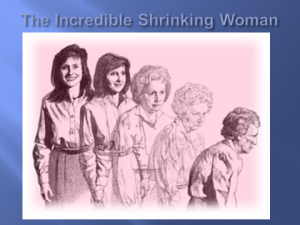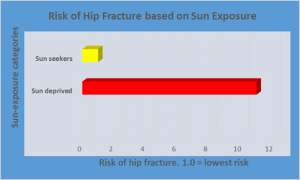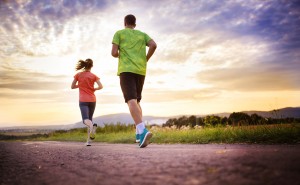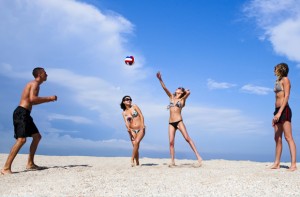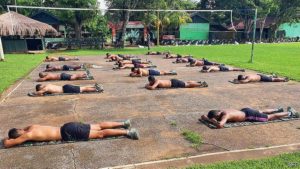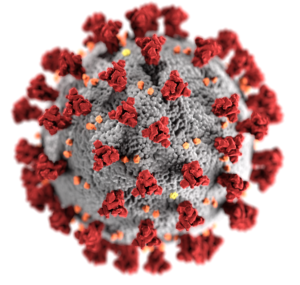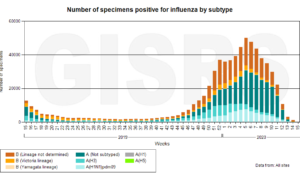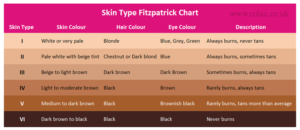Bone, vitamin D supplements, and sunlight By Marc Sorenson, EdD.
Bone and vitamin D are connected, yet, it may not be in the way you think. It is probably common knowledge that vitamin D is necessary for bone strength, particularly rickets. Yet, beyond rickets, it is not settled science that supplements significantly improve bone strength.
To prove this point, and to cause thoughtful consideration, I call your attention to a meta-analysis of 23 studies. The research assessed change in bone density (BD) from measurement inception to completion of each experiment. The bone densities measured the lumbar spine, femoral neck, total hip, trochanter, total body, or forearm. In addition, all participants took vitamin D supplements. There was little observable change in BD, so the results were disappointing. Thus, the researchers reported, in conclusion, “Continuing widespread use of vitamin D for osteoporosis prevention in community-dwelling adults without specific risk factors for vitamin D deficiency seems to be inappropriate.” Yet, before you give up on vitamin D for bone, let us consider the weakness of the research.
Does bone require much more than 800 IU per day to increase bone strength?
In 10 of the 23 studies cited above, the vitamin D dosage was less than 800 IU per day. This is rather like throwing a packet of food coloring into the sea and expecting the sea to turn red. Direct full-body sunlight during 10-15 minutes can stimulate the skin to produce up to 20,000 IU of vitamin D. Sunlight is the natural way to obtain vitamin D and numerous other healthful photoproducts. A minuscule dose of 800 IU will probably do little for bone strength. Yet, if the researchers had found studies using 3,000 and 5,000 IU, I could have more easily believed their conclusions. However, I could easily have been wrong, as you will see.
So are there other studies that make contradictory conclusions?
No. Most of the research using high-dose vitamin D supplements also had poor results. They usually resulted in much higher fracture risk for those taking the supplements. This was especially true in those who took large, intermittent doses and or intermittent intramuscular injections. Other data showed that doses of more than 4,000 IU daily are associated with more falls and fractures. In addition, research from the Journal of the American Medical Association showed an alarming trend. First of all, treatment with vitamin D for 3 years (4000 IU) day was counterproductive. Thus, it resulted in statistically significant lower bone mineral density (BMD) in certain bones. Furthermore, the same was true for 10,000 IU per day.
Are there better ways to keep bone strong?
Another factor to consider: vitamin D supplements may not be the same as vitamin D made by the human body. The skin always makes natural vitamin D for humans during exposure to sunlight and other sources of UVB light. Irradiating sheep’s lanolin produces the Vitamin D for supplements. Therefore, although 20,000 IU of vitamin D in 20 minutes is possible from sun exposure, the results are very different. Skin-produced vitamin D from sun exposure does not result in increased fracture risk and lower BMD.
The Spanish study on bone and sunlight
An important study from Spain shows that those who actively sought sun exposure had only 1/11 the risk of hip fracture compared to those who were not sun seekers! In this case, the sun-seeking people must have produced remarkable quantities of vitamin D. They also they increased bone strength remarkably. In addition, we know that the high vitamin D levels certainly caused no problem with bone density and bone strength! How can this be if high doses of vitamin D supplements lead to increased fracture rates? The difference, in my opinion, is the source.
Lessons learned, and conclusions
Therefore, we may take away important lessons from this treatise. First, vitamin D produced by sunlight is not the same as vitamin D from a pill. Moreover, vitamin D is a primary photoproduct of sun exposure. There is an exceptional difference between a pill produced from lanolin and a photoproduct produced in response to sunlight. If sun exposure can produce up to 20,000 IU of vitamin D, and it increases bone strength, something is awry with vitamin supplements, which decrease bone strength. We have produced evidence that show vitamin D supplements may increase bone fragility. It is time to accept the sun or other source of light as the major source of bone strength. That other source could be sunlamps or tanning beds.
A synopsis on bone and sunlight.
Finally, we must realize that sun exposure produces many photoproducts beyond vitamin D. Serotonin, endorphin, nitric oxide; brain-derived-neurotropic factor (BDNF) and dopamine are some of those photoproducts. All of them are vital to human health. Who is to say that these photoproducts do not form a synergistic relationship with sun-produced vitamin D to create the miracle of hip-fracture reduction? Do not neglect your regular, non-burning sun exposure. It may save your bones and your life.
Read more by visiting the Sunlight Institute, and read the book by Sorenson and Grant, Embrace the Sun. Happy Sunning!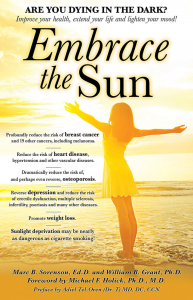
Sunlight, sex and sexual dysfunction. By Marc Sorenson, EdD.
Sunlight, sex and sexual dysfunction is a title that generally catches attention. Sexual dysfunction problems are rampant in our society, and those who claim to have answers usually draw immediate attention. Do I have answers and good advice? Probably—I will let you judge. Let us look at some research, and results gained, from sunlight and vitamin D.
Sexual dysfunction among women.
The first, and most recent women’s study, shows Vitamin D3 deficiency associates with Female Sexual Dysfunction (FSD) in Premenopausal Women. Moreover, we know that sun exposure to skin produces 90% of serum vitamin D levels. The scientists conducting this study measured vitamin D levels in 50 premenopausal women with FSD, and 58 healthy controls. The average age of the women was 35 years. Furthermore, all of these women completed a Female Sexual Function Index (FSFI) questionnaire. The investigators then correlated sexual desire, arousal, lubrication, orgasm, satisfaction and pain scores to the vitamin D levels. In addition, they evaluated all women for depression with the Beck depression Inventory (BDI).
Results for the women’s study:
Vitamin D levels were about 40% lower in the women with FSD than in the healthy controls. In addition, the results of each sexual function, spectacularly favored the healthy controls. Consequently, the researchers stated their results in this manner: “Desire (p = 0.0001), arousal (p = 0.0001), lubrication (p = 0.002), orgasm (p = 0.0001), satisfaction (p = 0.018), and pain (p = 0.010) domain scores were also correlated with the levels of serum 25-hydroxyvitamin D3.”
The p score or value means the probability value. Hence, it indicates the probability of obtaining test results at least as extreme as the results actually observed. Thus, the p-value for desire, arousal, lubrication and orgasm are extremely significant. The other sexual functions, satisfaction and pain (lack thereof), were also significant.
Why is sexual dysfunction in women so important?
A study in the journal, Sexual Medicine Review, showed that female sexual dysfunction affects 41% of premenopausal women around the globe. This is not normal, and in my opinion, is due to widespread sunlight deficiency. Sunlight deficiency leads to the deficiency of vitamin D, which results in untold suffering and frustration among women and their husbands. If something as normal and natural as regular, non-burning sun exposure could lead to a more satisfying sex life, would it not be worth the effort?
For more information on the terrific, healthful effects of sunlight and vitamin D, visit sunlightinstitute.org. In addition, read the book, Embrace the Sun.
Sunlight prevents breast cancer. By Marc Sorenson, EdD.
Sunlight prevents breast cancer by many means. Many scientists believe this. Moreover, sunlight also stimulates human skin to produce vitamin D. Therefore, many professionals assume vitamin D is responsible for the reduced risk. Thus, this may lead them to advocate the use of vitamin D supplementation and totally miss the bigger picture. In addition to vitamin D, sunlight or sunlamps produce many supplementary and healthful photoproducts. Among others, sunlight produces nitric oxide, dopamine, serotonin, endorphin and brain-derived neurotropic factor (BDNF). In addition, all these photoproducts are vital to health. Hence, it is likely that these healthful photoproducts lead to an inhibition of breast cancer.
New research shows that sunlight prevents breast cancer independently of vitamin D.
Consequently, it should not surprise us that for breast cancer, sunlight’s effects go beyond vitamin D. Researchers at Children’s Hospital Oakland Research Institute, used a mouse model that easily develops breast cancer. They also treated them with UVR light such as found in sunlight. Much as we might expect, they found that UVR treatments produced significant anti-cancer effects. Furthermore, they found that neither dietary vitamin D nor topical vitamin D influenced cancer risk. Because of their findings, they stated the following: “UVR’s inhibitory effects occur irrespective of whether or not the treatment increases circulating D3 in the mice.” Then they also made another important comment regarding their research. “Therefore, supplemental D3 may not mimic all possible beneficial effects of UVR. Uncovering non-D3-mediated mechanisms of UVR tumor inhibition may lead to novel strategies for cancer prevention.”
An important point about how sunlight prevents breast cancer.
Finally, there is no doubt that vitamin D has anticancer benefits. This research however, is especially relevant because it corroborates what I have said in my book, Embrace the Sun. Consequently, we must not put all of the benefits of sunlight in the vitamin D box. Furthermore, sun exposure performs myriad miracles beyond vitamin D. One of those miracles may be breast cancer prevention and inhibition. In addition, if we erroneously believe we can obtain all of the sun’s benefits from popping a pill, we may miss the holistic effects sunlight, which provide a cornucopia of salubrious results.
So, safely (without burning) embrace the sun, since it helps prevent breast cancer.
For more information, visit sunlightinstitute.org. Another great tip is to read the book, Embrace the Sun.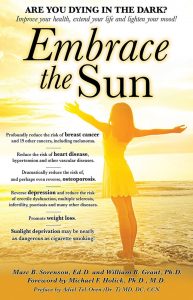
Happy sunning!
Sunlight outside the body stops transmission of Covid-19. By Marc Sorenson, EdD.

Sunlight outside the body, as regards Covid-19, may be a rather new and intriguing concept. Yet, we have alluded to it briefly in a previous blog. Research from the Department of Homeland Security (DHS) corroborates the idea that direct sunlight rapidly kills the Covid-19 virus. The researchers tested effects of sunlight on Covid-19 viruses in aerosols, suspensions of solid particles or liquid droplets in air. These aerosols represent a potential route of disease transmission, and in this case, transmissions of Covid-19 viruses. Therefore, if sunlight exposure accelerates the decay of these viruses, it prevents an avenue of human-to-human transmission. Thus, breathing in of viruses coughed, sneezed, or even breathed out by others (as in saliva) ceases to be problematic. Sunlight outside the body inactivates the viruses due to decaying them.
The bottom line regarding outside sunlight and Covid-19.
Because of this research, it we know that without sun exposure, the time required to decay the virus was 125 minutes. With direct sunlight, the time ranged from 6 to 19 minutes, according to the intensity of the exposure. That is a profoundly significant change, and is probably why Florida fared so much better than New York, with Covid-19.
Hence, we have shown that sunlight is a two-edged sword; sunlight outside the body helps to halt transmission of the disease. Sunlight’s ability to produce vitamin D in the skin (inside the body) prevents the cytokine storm, which is how Covid-19 kills.
People have long believed that sunlight was the best disinfectant.
First, the German microbiologist Robert Koch, who isolated TB bacteria in 1882, showed that sunlight had disinfectant qualities; it destroyed tuberculosis bacteria. In addition, even earlier, in 1877, other researchers discovered that sugar water left in the shade became cloudy, indicative of bacterial growth. However, if exposed to sunlight, it remained clear. Dr. Zane Kime, in his book, Sunlight Could Save Your Life, wrote that history. In addition, he also reviewed the results of research conducted between 1886 and 1909. Most noteworthy, it showed that the following bacteria succumbed to ultraviolet light: Anthrax, plague, streptococci, tubercle bacillus, cholera, staphylococcus, colon bacillus and dysentery bacillus. Nevertheless, most people forgot sunlight with the advent of antibiotic drugs, but now the interest has returned. (Cited in Kime, Z. Sunlight Could Save Your Life. World Health Publications, Penryn, CA 1980:126-30.) Also, read Embrace the Sun.
So, please realize that the master disinfectant, sunlight, is the best in the world. Thus, it is ready to do battle with the worst the Covid-19 virus can throw at the human body. Get your share of non-burning sunlight and survive this pandemic. For more information, visit sunlightinstitute.org and read the book, Embrace the Sun.
Happy sunning!
Coronavirus, sunlight and vitamin D. More compelling information. Take action now. By Marc Sorenson, EdD.

 Coronavirus, (Covid-19), like most flu-like diseases, will probably disappear in much of the Northern hemisphere in the coming summer. Nevertheless, it will return on steroids in the fall and winter. Yet, it does not have to return to you or your family and friends. We can do something! However, why wait? Let us start now! Does anyone reading this really want to wait for the “second wave” and then go into panic mode? Of course not. In addition, do you want to let the vaccine Nazis also spend $billions more of our tax dollars looking for a vaccine? Of course not. The answer to stopping coronavirus is all around us. We need only to seek it and use it.
Coronavirus, (Covid-19), like most flu-like diseases, will probably disappear in much of the Northern hemisphere in the coming summer. Nevertheless, it will return on steroids in the fall and winter. Yet, it does not have to return to you or your family and friends. We can do something! However, why wait? Let us start now! Does anyone reading this really want to wait for the “second wave” and then go into panic mode? Of course not. In addition, do you want to let the vaccine Nazis also spend $billions more of our tax dollars looking for a vaccine? Of course not. The answer to stopping coronavirus is all around us. We need only to seek it and use it.
Two papers show remarkable associations of coronavirus with vitamin D.
If you are not convinced of the power of sunlight after reading this, I despair of being able to help you prevent this fall’s “second wave.”
The first paper was by a team of Indonesian researchers. One might think that Indonesians would have ample vitamin D levels due to an abundance of sunlight. Thus, this should protect them from vitamin D deficiency. However, most Indonesians avoid the sun and keep their skins as white as possible. It is a national quest in the Philippines to be as light-skinned as possible, so that they can consider themselves as “upper crust.” Hence, the population has a great deal of vitamin D deficiency.
The researchers focused on identifying patterns of mortality (death) between coronavirus deaths and vitamin D levels. They conducted the study with a sample of 780 subjects, all who had laboratory confirmed coronavirus infection.
Here are the findings on vitamin D levels and coronavirus mortality:
- Mortality rates were 13 times higher in patients who were vitamin D insufficient (21-29 ng/ml) compared to those who had normal levels (>30 ng/ml).
- Mortality rates were 19-times higher in patients who were vitamin D deficient (<20 ng/ml).
- Even when controlling the data for age, gender and preexisting conditions, the vitamin D deficient cases were more than 10 times more likely to die than those who had normal levels.
No wonder the Indonesians are now seeking the sun and appreciating it after years of avoiding it. See the picture below of Indonesian men social distancing while soaking up the rays.
An important point regarding vitamin D and coronavirus:
Vitamin D levels above 30 ng/ml are not necessarily “normal,” and it is likely that 50-60 ng/ml would be a better number. People who are constantly in the sunshine, i.e. lifeguards, often have levels above 70 ng/ml. Dr. Bruce Hollis and his colleagues suggested that lifeguards have the “true normal” levels. They believe that a population of “normal” volunteers with average levels of 27 ng/ml may exhibit vitamin D deficiency. Another similar study showed that “normal” adults had 25(OH)D levels of about 27.2 ng/ml, whereas lifeguards had levels of approximately 70 ng/ml].
Could the real pandemic be a pandemic of sunlight deficiency resulting in a pandemic of vitamin D deficiency?
If >30 ng/ml provides this much protection against coronavirus, levels > 60 ng/ml would probably provide complete protection. Everyone should have a vitamin D assessment, and then get out in the sun, during this time of the coronavirus epidemic. For your own health, and the health of those you love, schedule a test, and make your goal 60 ng/ml.
Paper # 2
Another paper by Mark Alipio, done in the Philippines, was similar to the Indonesian study. Thus, it showed that coronavirus patients with normal vitamin D levels had a mild disease outcome. The outcome for those patients was 19.6 times better than for those with low levels.
A fact everyone should remember:
Ninety percent of serum vitamin D levels are due to sun exposure, which causes the skin to produce vitamin D3. Therefore, vitamin D levels are surrogate measurements for sun exposure. You must not assume that vitamin D capsules will supply all the beneficial effects of sun exposure or sunbed exposure. Both sunlight and sunbed light produce photoproducts that have health effects far beyond vitamin D. Safely sunbathe (without burning) to achieve optimal vitamin D levels. Moreover, while so doing, you will produce other remarkably important health benefits.
For more information on the extraordinary health benefits of sun exposure, visit sunlightinstitute.org and read my book, Embrace the Sun.
Cytokine storms may cause death and destruction during coronavirus (Covid-19) infection. Therefore, we should take measures to prevent them. In that manner, we can shorten the lethal path of Covid 19.
Answers to the coronavirus epidemic. By Marc Sorenson, EdD
Cytokine storms are major causes of death from coronavirus (Covid-19) and resultant pneumonia.
- This article will present information showing that we may have the tools needed to suppress coronavirus (Covid 19).
- The article will explain how the cytokine storm kills persons with coronavirus infection.
- It will explain the role of vitamin D in suppressing the cytokine storm.
- The presentation will show that non-burning, regular sun exposure is superior to taking a vitamin D supplement.
- It will show, graphically, the seasonal nature of flu-like diseases and make it clear where the sun fits in.
- The article will show the efficacy of sunlight for Covid-19, both outside and inside the body.
- The presentation will include information on the terrific increase in death among African Americans. African Americans need far more sun exposure than people with lighter skin.
- It will present information on the incredibly healthful effects of sunlight both with and beyond vitamin D.
- This article will expose the lies and present the truth about melanoma, to remove the fear of sun exposure for that disease.
- The presentation will elucidate the concerns about different skin types, and present them graphically.
- The presentation will also articulate the truth about sunscreens and explain the best method for preventing damage once one has had sufficient sun exposure.
- The article presents methods to keep vitamin D levels high in areas of little sunlight. It also presents the means to survive winter, when no UVB light exists to produce vitamin D.
- The presentation will discuss information on obesity, diabetes and heart disease, which are each associated closely to death from Covid-19.
- This discussion provides information showing that sunscreen use may quash the ability of sunlight to produce vitamin D. This will inhibit the body’s ability to stop the cytokine storm.
Breaking news!
As I prepared to post this article, Yahoo released news of transcendent importance. They corroborated statements about sunlight being able to kill Coronavirus. I had been making this statement since the first onslaught of the virus. Some people agreed and some ridiculed me. This Yahoo information from the DHS vindicates me!
The headline reads Sunlight destroys virus quickly. [Emphasis mine]. They also stated that “simulated sunlight” killed the virus. The government tests proved the efficacy of sunlight. The remainder of this article now has an even greater validity.
What is coronavirus or Covid-19?
Coronaviruses are a group of viruses that infect birds and mammals. These viruses infect the respiratory passages with such diseases as influenza and the common cold. They also lead to some severe diseases such as Middle East Respiratory Syndrome (MERS) and Severe Acute Respiratory Syndrome (SARS). The most recent of these diseases is Covid-19.
An important fact: the most severe respiratory pandemic was the Spanish flu of 1918-1919, which probably killed 50-100 million people. This flu started in March 1918. Vitamin D levels would have been lowest during that time. The flu subsided during the summer (time of highest vitamin D levels), and rebounded with a vengeance in the fall.
A second important fact: If you die from coronavirus, it is likely that your own immune system will kill you. You will die from a cytokine storm.
What is a cytokine?
A cytokine is a specialized protein molecule that attacks and destroys an infection. These proteins can be either pro-inflammatory of anti-inflammatory. For our purposes, we will primarily discuss pro-inflammatory cytokines.
What is a cytokine storm? Usually, the cytokine needed to fight the infected tissue stops its attack after it has won the battle. However, in the case of a disease like influenza (or Covid-19), “friendly fire” occurs. The body’s immune system recruits millions of “extra” or reinforcing cytokines, and those cytokines mount an overwhelming attack against the tissue they initially protected; in other words, they cause a storm. Cytokine storms lead to severe inflammation that weakens or destroys blood vessel membranes in the lungs. This causes fluid to seep through to the air sacs, which leads to pneumonia. A person then ends up drowning in his own body fluids. Dr. Angela Rasmussen describes it thusly: “Basically you’re bleeding out of your blood vessels.” She goes on to say that the problem may not end there. The storm spills into the circulatory system and can create systemic issues across multiple organs.
Does vitamin D thwart the cytokine storm?
Vitamin D leads to the production of cathelicidins and defensins, which are peptides (proteins) with antimicrobial properties. According to Dr. William Grant and colleagues, these peptides lower viral replication rates and reduce concentrations of pro-inflammatory cytokines. These cytokines produce the inflammation that injures the lungs. Nevertheless, the damage does not necessarily end in the lungs.
Recent research shows that the damage from Covid-19 can spread to multiple organ systems. The report on this research suggests that the cytokine storm may be responsible for that spread. The heart, liver, kidneys, neurological system and gastrointestinal tract may all be targets of Covid-19 beyond the lungs.
In addition, Dr. Grant and colleagues list the following reasons to believe that vitamin D could reduce the risk of the coronavirus:
- Inducing production of cathelicidins and defensins that can lower viral survival and replication rates as well as reduce risk of bacterial infection
- Reducing the cytokine storm that causes inflammation and damage to the lining of the lungs that can lead to pneumonia
- Additionally, vitamin D deficiency contributes to acute respiratory distress syndrome, a major cause of death associated with COVID-19.
If what I posit were true, we would expect Covid-19 to be higher in populations with high vitamin D deficiency, and such is the case.
Henry Lahore, one of the great vitamin D scholars, has listed four racial groups with disproportionately high vitamin D deficiency: Elderly Italians, Spanish, Swedish Somalis and African Americans.
Many of you have read of the alarmingly high Covid-19 death rate in African Americans. From my previous research, I know that African Americans also have alarmingly low vitamin D levels. Lahore also cites research that shows 84% of African Americans are vitamin D deficient. In addition, in Chicago, 70% of Covid 19 deaths are among Blacks. The reason for the deficiency? Dark skins take much more time in the sun to produce vitamin D. Unfortunately, our answer to Covid-19 has been to cocoon everyone indoors, which assures that no one can obtain any vitamin D except by supplement; that is, unless they are fortunate enough to own sunlamps or sunbeds (tanning beds).
An alarming situation in Sweden
Even more alarming is that the Swedish Somali population has 40% of the deaths in Sweden. Yet, they comprise only .84% of the Swedish population. In other words, the Dark-skinned Somalis have 4,700% greater risk of death from Covid 19! This can only be due to lack of sufficient sunlight and subsequently, low vitamin D. No such death risk exists in Africa, where sunlight is abundant.
Does sun exposure make a difference?
We live in a world that is mostly vitamin D deficient. Even sunnier states and countries have an increasing problem. However, Northern countries are at much more risk for Covid-19. The reason for the growing risk in sunny countries is the misguided advice to stay out of the sun and wear sunscreens, which can stop the production of up to 99% of vitamin D. I believe we must stop shunning the sun if we wish to halt flu epidemics, including the current Covid-19 epidemic. Otherwise, we will spend our time pursuing vaccines for a disease whose answer is already available. The real pandemic is the pandemic of sunlight deficiency.
If sunlight makes a positive difference for flu, and suppresses the cytokine storm, we would expect to see decreases in flu during the sunny season.
This is exactly the case. Consider the following chart: (Produced by WHO), sent to me by Goran Olsson, Moscow, Russia).
Observe what happens in the sunny part of the year. The incidence of flu virtually disappears. So, when the experts hypothesize that Covid 19 will spike again this fall, they are correct. That is, unless corrective measures are taken.
There are those who believe that warm temperature halts flu in summer. However, if that were true, we would need only to turn our thermostats up to 90 degrees to kill the virus and stop the cytokine storm. It is sunlight, not warm temperature, which is the great healer.
There are two ways in which sunlight helps halt the flu and probably Covid 19.
First, exposure to sun produces 90% of serum (blood) vitamin D. Supplementation or food sources produce only a minuscule quantity of vitamin D. Full-body sun exposure for 10-15 minutes can cause the skin to produce 20,000 IU of vitamin D. Based on this fact, here is the effect of sun exposure on the Covid 19 equation:
Sunlight-> vitamin D ->inhibition of the cytokine storm-> Prevention or stoppage of death from Covid-19.
Secondly, sunlight is the best disinfectant, and many viruses live longer outside the body when sunlight is lacking. Whether this is true for Covid-19 is conjecture. It would be good to do that research now. Regularly disinfecting homes with UV light would be easy and safe.
A common and dangerous misconception regarding sun exposure and vitamin D: “I don’t need sunshine; I need only vitamin D supplements.”
This statement shows a lack of knowledge. If we are to use sunlight to ramp up our vitamin D and other healthful photoproducts, we must stop fearing the sun. If we want to shut down the cytokine storm, we must develop a friendly, but careful relationship with sunlight. For health, sun exposure goes far beyond vitamin D. Here are more benefits of sunlight, including, but not limited to the benefits of vitamin D. For full documentation of these statements, read Embrace the Sun by Drs. Marc Sorenson and William Grant.
The prevention or reversal of the diseases underlined below do not depend on vitamin D.
- Influenza diminishes almost to nothing during late spring, summer, and early fall, times of greatest sun exposure and vitamin D production. See the graph above.
- Seventy-five percent of melanomas occurs on areas of the body seldom or never exposed to sun.
- Women who sunbathe regularly have half the risk of death during a 20-year period compared to those who stay indoors.
- A Spanish study shows that women who seek the sun have one-eleventh the hip-fracture risk as sun avoiders.
- Men who work outdoors have half the risk of melanoma as those who work indoors.
- Women who avoid the sun have 10-times the risk of breast cancer as those who embrace the sun.
-
More benefits of sunlight exposure
- Multiple sclerosis (MS) is highest in areas of little sunlight, and virtually disappears in areas of year-round direct sunlight.
- Sun exposure decreases heart disease risk through nitric oxide production.
- Sun exposure dramatically improves mood through production of serotonin.
- Those persons who spend many hours daily outdoors have only 1/50 the risk of Parkinson’s disease!
- For each death caused by diseases associated with sun exposure, there are 328 deaths caused by diseases associated with sun deprivation.
- Sun exposure increases the production of BDNF, essential to nerve function.
- Sun exposure can produce as much as 20,000 IU of vitamin D in 20 minutes of full-body sun exposure.
- In the U.S., vitamin D deficiency in children has increased by 83 times during a 14-year period. That is likely due to indoor living and sunscreen use.
Another sunlight concern, which should really be a non-concern: “if people soak up the sun, they will contract melanoma.”
To dispel this myth, here are the facts about melanoma, fully documented in the book, Embrace the Sun. This should belie the misinformation regarding melanoma and sunlight.
Seventy-five percent of melanomas occur on body areas seldom exposed to sunlight.
- In the U.S., as sun exposure has decreased by about 90% since 1935, melanoma incidence has increased by 3,000%. Documentation in Embrace the Sun. See the graph below.
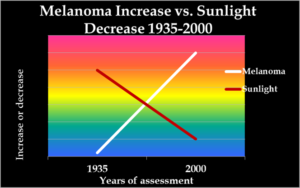
- As in the US, while sun exposure in Europe has profoundly decreased, there has been an exponential increase in melanoma.
- Men who work outdoors have about half the risk of melanoma as men who work indoors.
- Outdoor workers, while receiving 3-9 times the sun exposure as indoor workers, have had no increase in melanoma since before 1940, whereas melanoma incidence in indoor workers has increased steadily and exponentially.
- Sunscreen invention, along with its steadily increasing use, has not reduced the risk of melanoma. In fact, it has melanoma has increased as sunscreen use has increased. Documentation in Embrace the Sun.
- Increasing melanoma incidence significantly correlates with decreasing personal annual Sunlight exposure.
- Outdoor workers do get numerous sunburns but still have a dramatically lower risk of contracting melanoma.
Thus, melanoma increases as sun exposure decreases. Should we continue to blame the sun?
Here are more facts about melanoma and its prevention:
People in the highest quintile (fifth) of alcohol consumption have a 65% increase in melanoma risk.
- Weekly meat consumption increases melanoma risk by 84%. This is important to know for my non-vegetarian friends. (See the graph below.)
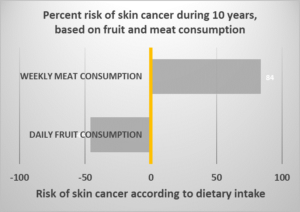
- Daily fruit consumption reduces the risk of melanoma by nearly 50%. (See the graph ).
- Persons with the highest levels of blood PCBs (now-banned industrial chemicals) have 7-times the risk of melanoma as those with the lowest levels.
- Recent use of Viagra is associated with an 84% increase in melanoma risk, while long-term use of the drug is associated with a 92% risk increase.
- There is a positive association between melanoma and obesity. It is interesting that the increases in both diseases have progressed in unison.
A caveat regarding skin type: All people need sun exposure. However, people who have type-one skin must be very cautious.
Type-one skin may not tan, and should not have direct exposure to sunlight, at least in the beginning stages of a sunning program. Nevertheless, those who have type-one skin may carefully go outside and sit in the shade with the sun shining around them, or they could sit under a beach umbrella during a sunny day. The key is the amount of time it takes to show a slight pinkness. If that time is only a minute, then the person should go inside after that minute and cover up with clothing.
How to change your environment when you have had enough sun exposure.
If it takes longer for pinkness to occur, then stay longer. After a few days, the skin will acclimatize somewhat and longer times could be enjoyed. After the sunning session, it would be appropriate to don long pants, large hat, long sleeves and light gloves. The advantage for people with type-one skins is they produce large quantities of vitamin D and other photoproducts in a very short time. They, therefore, can quickly optimize the body’s ability to suppress the cytokine storm and to derive the other benefits of sun exposure that we previously listed. Sunbathing, or “shade bathing,” for those with type-one skin is the best way to obtain vitamin D.
Important information for African Americans, who need more vitamin D to suppress the cytokine storm.
In addition, this is a message to our two dear friends (African Americans) in San Francisco. You must spend much more than 10-15 minutes in the midday sunlight to optimize your vitamin D levels. Try to get at least 40-60 minutes of full-body exposure on each side of the body. This of course, applies to all African Americans. As with all races, be careful not to burn. For a person with very dark skin (type five-six) on the graph below, it takes an hour to produce the same quantity of vitamin D that a type-one can produce in a few minutes.
The following is a chart for determining skin type. Remember, that for every skin type, the primary warning is to avoid sunburn.
Many people believe that a few minutes outside, with face and hands exposed, will optimize vitamin D levels. However, that method takes far more than a few minutes to produce optimization. It may take all day, according to your skin type. If you find an area to sunbathe at midday with little or no clothing, you can produce up to 20,000 IU of vitamin D in as little as 10-15 minutes on each side of the body. After that, you can cover up with long pants, a large hat, long-sleeve shirt and even light gloves and continue to enjoy the outdoors.
An important statement from dermatologists and other organizations in the UK.
Here is a related statement from several health organizations in the UK, including the British Association of Dermatology (hard to believe, I know) “Vitamin D is essential for good bone health, and for most people sun is the most important source of vitamin D. The time required to make sufficient vitamin D varies according to a number of environmental, physical and personal factors, but is typically short and less than the amount of time needed for skin to redden and burn. Enjoying the sun safely, while taking care not to burn, can help provide the benefits of vitamin D without unduly raising the risk of skin cancer.” Documented in Embrace the Sun.
What about Areas of little sunlight?
However, suppose you live in unpredictable sun areas like Ely, Nevada or Ely, Minnesota, or Olympia, Washington or Toronto, Canada. As long as you can access unobstructed, midday summer sunlight twice weekly, as described above, you can count on optimized vitamin D levels. There is an exception for African Americans. An extra day per week would probably be a good idea.
Remember, no vitamin D production occurs during early morning of late afternoon. Nevertheless, many other healthful effects of sunlight are available all day long. Also, remember that in the beginning stages of your suntanning program, be careful not to burn yourself. If you begin to redden, leave the sun. Gradually acclimatize your skin to the sun.
Other facts about Covid-19, death and the cytokine storm:
Obesity is a major factor.
Obesity increases the risk of death from Covid-19. It is an inflammatory disease, as is Covid-19. In addition, it appears that a combination of the two can be deadly. This is predictable, because both the cytokine storm and obesity are inflammatory conditions. It is like pouring gasoline on a fire.
New York is the epicenter for Covid-19 in the U.S. NYU has determined that obesity and age are the two major deciding factors for hospitalization there.
People are thinner when they are outdoors and active.
Thus, the cocooning is likely adding to the likelihood of obesity. In addition, stay-at-home orders are neither conducive to sun exposure nor vitamin D optimization. I do not have the research to prove this point, but I believe that the enforced indoor living has added to the obesity crisis. How many bowls of ice cream do cocooned people consume nightly in front of the TV?
In our sun-drenched health resort, our clients lost more than 100 tons of fat during our careers. Much of that success was due to a mostly animal-free nutrition program. Yet, sun exposure does reduce weight. This is especially true of early-morning sun exposure. Early-morning sun exposure reduces obesity without the benefit of vitamin D. We know this to be true, because early morning sun exposure does not contain the UVB light necessary for vitamin D production. Nitric oxide or serotonin, produced throughout the day, could be the operative factors.
Type-two Diabetes is a major factor for death from Covid-19. Type-one is probably a factor also, but it comprises only 5% of cases. In addition, studies do not exist on the relationship of type-1 to Covid-19. Diabetes, then, is either directly or indirectly associated with the cytokine storm.
According to Morbidity and Mortality Weekly Report, Covid-19 patients taken to the ICU were more likely to have diabetes than any other underlying condition. In our former health resort (very sunny), two-thirds of type-two diabetics were free of all diabetic medications, including injected insulin, in 11.7 days. That number reached 85% in those who stayed four weeks. Of the 15% that were still using medication, almost all of them dramatically reduced their dosages. If people would simply embrace the sun and eat a plant-based diet, diabetes would cease to be a problem. Why? Because diabetes would mostly cease to exist.
Research on sunlight and diabetes:
Several papers have shown an association between sun exposure and diabetes. One paper showed that blood-sugar levels were lower during the summer, and another demonstrated that exposure to sun lamps increased insulin secretion.
In addition, a meta-analysis produced evidence that recreational sun exposure is associated with a reduced risk of type-two diabetes. The study was undertaken because the researchers observed that higher vitamin D levels were consistently associated with lower diabetes risk. Yet, there was not a relationship between vitamin D supplementation and diabetes. I must make a point here: Do not trust a vitamin D capsule to have all the health benefits of sun exposure or other UVB exposure.
Heart disease (cardiovascular disease) is a major factor for death from Covid-19.
Research from the same journal, Morbidity and Mortality Weekly Report, showed “10 % percent of COVID-19 patients with cardiovascular conditions died — the highest rate of fatalities among common underlying conditions — compared with 2.3 percent of the entire population of patients.” At our health resort, clients reduced cholesterol levels (predictive of heart disease, stroke and other vascular diseases) by as much as 700 points.
In addition, they sometimes lowered blood pressure remarkably in only one-four weeks. Angina often disappeared. In my opinion, the plant-based nutrition program, and the predictable sunny days in Saint George, Utah, both contributed to those results. One of our clients who had scheduled himself for open-heart quadruple bypass surgery, checked in at the health institute instead. His heart disease never gave him another problem. He was about 65 years old at that time and is now about 87. He never had a bypass operation.
Research on sunlight and heart disease.
Research indicates that sun exposure in summertime among gardeners correlates to lower cholesterol levels and decreased risk of heart attack. HDL cholesterol is protective against heart disease, and LDL cholesterol is a risk factor. A study in Chile showed that HDL decreases in the winter, and LDL is significantly higher in winter/spring than in summer. Of course, sunlight is much more prevalent in summer, hence the difference. A study on seasonal variations in heart attack rates in Brazil demonstrated a 30% higher risk in winter than summer. One study of hypertensive subjects shows that blood pressure levels average 165/90 in winter but 134/74 in the summer, and both stroke and heart attack rates double in the winter. We could list dozens of additional citations, but these will suffice for this short paper.
Should we use sunscreens while we sunbathe?
The simple answer is “no.” If people feel they have had sufficient sun exposure, they should seek shade, cover up or go inside.
There are many excellent reasons NOT to use sunscreens:
Two major studies in 2019 showed that sunscreens might be worthless or even harmful. The first, a meta-analysis, showed no protective effect of sunscreens against skin cancer. The second showed that people who used sunscreens had up to six times the number of sunburns compared to those that did not use them. This research also demonstrated that those who covered up, or sought shade when they had enough sun, were far less apt to sunburn than those who used sunscreens. In addition, in the last four decades, sunscreen use has increased by 400%, while melanoma incidence has also increased by 400%.
Sunscreens are also destroying coral reefs. Hawaii has banned them. Moreover, and perhaps most importantly, research shows that an SPF 15 sunscreen will decrease sun-stimulated vitamin D production by 99.5%. If it were our desire to thwart Covid-19, and halt the cytokine storm, why would we use sunscreens that suppresses vitamin D?
One of the primary government concerns is that after the summer, Covid 19 will mount a comeback, or second wave. Indeed, it will, if something does not replace the UV light from sunlight. Along with the disease, the cytokine storm will return in force.
Let us consider winter, when sunlight no longer contains UVB light to produce vitamin D. Go to the previous chart above on seasonality of flu and look at the tremendous increase that occurs in winter. How do we keep the virus under control? The answer is to use a sunbed (tanning bed). The sunbed must not be a high-pressure bed, as those beds produce little vitamin D.
I can already hear the collective screams of agony. Those screams emanate from the American Academy of Dermatology (AAD) and others as they read the vitamin D/sunbed statement. They are yelling, “How can he advocate sunbeds!?”
Do you want to read the truth about the AAD and other anti-sun, anti-tanning organizations? Then read the book, Embrace the Sun, which contains a full exposé.
Now, let us present the documented truth about sunbeds—truth that will never be presented by the anti-sun, anti-tanning organizations. Here are the facts about the healthful effects of sunbeds:
- A 20-year study demonstrated that both sun exposure and sunbed exposure reduced the risk of death; women who used sunbeds were 23% less likely to die from any cause than women who did not use them.
-
Sunbed use is associated with increased vitamin D levels.
- People in Canada who use sunbeds have far higher vitamin D levels that the rest of the population. What a protection against the cytokine storm!
- In addition, another study showed that sunbed users had 90% higher vitamin D than non-users. The same study showed higher bone-mineral density, indicative of stronger bones.
- These impressive machines are associated with lower breast-cancer risk.
- Sunbed use can cure psoriasis and eczema, and dermatologists often recommend sunbeds.
- Thrice yearly sunbed use is associated with a 40-50% reduced risk of endometrial cancer.
- Sunbed use is associated with a reduced risk of clots.
- They are also able to alleviate pain.
Refuting the Powers of Darkness (anti-sun organizations) regarding sunbeds. The Powers of Darkness are not interested in your cytokine storms.
Sunbeds (tanning beds), as you have learned, have many healthful properties. They produce vitamin D, strengthen bone and reduce the risk of major cancers. In addition, they may hold a key to stopping Covid 19 and the cytokine storm. Yet, the Powers of Darkness continue to malign them as being a major cause of melanoma. Thus, through misguided legislation, they ban teens in many areas from using them. In addition, tanning- salon owners must live in fear of government overreach that could put them out of business.
Because of this uproar, a group of scientists (some dermatologists), led by Dr. Jörg Reichrath, did a thorough research review. Furthermore, they published their findings in 2020 in a major scientific journal called Anticancer Research. That research presented the truth about melanoma and sunbeds. Here are four results of their review:
1.A study from Europe demonstrated that sunbed use was associated with a 30% reduced risk of developing melanoma.
2.They stated, “We found no studies that demonstrate a causal relationship between moderate solarium use and melanoma risk.”
3.The anti-sun research was low quality, and bias may have existed.
So, do not believe everything you hear about sunbeds from the Powers of Darkness. My belief is that sunbeds may hold the key to stopping the winter spike in Covid-19 cases.
You should always use sunbeds at a tanning salon whose employees are skilled in assessing skin types. That will keep you safe as you optimize your vitamin D and inhibit the cytokine storm.
How do you know if your serum Vitamin D is sufficient to suppress the cytokine storm?
Everyone should have a test for vitamin D levels. The goal is to produce a level between 50 and 70 ng/ml.
How do I know my time outside is producing vitamin D?
- If the media reports a UV index of three or more, and you are outside, not using sunscreen, vitamin D production occurs.
- If your shadow is shorter than your height, you are producing vitamin D. Thus, the shorter the shadow, the better. The shadow will be shortest at midday.
- To produce the greatest amount of vitamin D, find a private area and sunbathe, using as little clothing as possible. As mentioned, this can produce up to 20,000 IU of vitamin D in as little as 10-15 minutes of sun exposure at midday.
What have you learned from this article regarding Covid 19, sunlight, vitamin D and the cytokine storm?
Here is a list:
- This article presented evidence showing that we have the information needed to suppress coronavirus (Covid 19).
- The article explained how the cytokine storm kills persons with coronavirus infection.
- It also discussed the role of sunlight and vitamin D in suppressing the cytokine storm.
- It presented information that non-burning, regular sun exposure is superior to taking a vitamin D capsule.
- The article showed, graphically, the seasonal nature of flu-like diseases.
- This paper showed the efficacy of sunlight for Covid-19, both outside and inside the body.
- The presentation included information on the terrific increase in death among African Americans with Covid 19.
-
More lessons learned regarding sunlight and cytokines.
- The information showed the incredibly healthful effects of sunlight both with and beyond vitamin D.
- The presentation exposed the lies and presented the truth about melanoma, to remove the fear of sun exposure for that disease.
- The presentation elucidated the concerns about different skin types, and presented them graphically.
- The paper articulated the truth about sunscreens and explained the best method for preventing damage once one has had sufficient sun exposure.
- It presented the methods for keeping vitamin D levels high in areas of little sunlight and explained methods for surviving winter, when no UVB light exists to produce vitamin D.
- The presentation gave information on obesity, diabetes and heart disease, which are each associated closely to death from Covid-19.
- This discussion presented information that sunscreen use may quash the ability of sunlight to produce vitamin D. This will inhibit the body’s ability to stop the cytokine storm.
The materials in this paper cover the pertinent facts about Covid-19 and sunlight. However, no one can know all the facts, and this material does not replace your personal health advisors. Consult them before making lifestyle changes.
Please share this material with your physicians, friends, parents, siblings, social-isolating acquaintances, government entities, social media, regular media, and newspapers. The information contained herein may save their health and our economy. Until then, remember that neither sunlight nor sunbeds are enemies. In fact, they may save your life!
Happy sunning!
UV index. Vita min D and health. By Marc Sorenson, EdD
min D and health. By Marc Sorenson, EdD
The UV index is a measure of the intensity of ultraviolet radiation B (UVB) from the sun. It is expressed as a number on a scale of 0-11. A higher number indicates a higher sunlight intensity. Exposure to the ultraviolet B (UVB) portion of sunlight is necessary to cause the skin to produce vitamin D. Nevertheless, unless the body is deeply tanned or naturally very dark, a very high UV index can cause sunburn, so caution is necessary.
A low UV index is also problematic.
However, if the UV index is very low, it cannot stimulate the production of vitamin D in the skin. Vitamin D production is essential for human health. Thus, lack of vitamin D may be a major reason that flu-like diseases occur primarily during winter, when there is little or no vitamin D production. This, of course varies according to latitude.
A List of vitamin D benefits from Business Insider.
A recent article from Business Insider (a Philippines online paper) discussed various health effects of vitamin D and sun exposure. Here are some of their salient points, not all of which are correct.
- The primary cause of vitamin D deficiency is sun deprivation (correct).
- Vitamin D helps keep the immune system, so deficiency could be the reason for frequent flu (correct).
- You can get more vitamin D by spending at least 5 to 10 minutes outside 3 times a week without sunscreen (correct).
How much vitamin D does a person need?
- The most incorrect statement of the article is this. The average adult needs around 600 international units (IU) of vitamin D a day (not correct). For reference, a serving of salmon contains roughly 400 IU (not correct). 20 minutes of full-body, unobstructed sunlight can cause the skin to produce up to 20,000 IU of vitamin D. If 600 IU were the only source of vitamin D, one would produce a level of six ng/ml, which would be woefully inadequate. 600 IU is only slightly better than nothing.
- Fifteen minutes of non-burning midday sun (without sunscreen) would optimize vitamin D levels in a few days. Dark-skinned individuals would need much more exposure, up to an hour.
-
Getting more frequent colds or respiratory infections could be a symptom of vitamin D deficiency (correct). However, it is even more likely to be a sign of sunlight deprivation.
- Colds and flu nearly disappear in the summer when the sun is direct. During this time of the coronavirus epidemic, everyone on earth needs daily direct or indirect sun exposure. Those who do not tan can obtain plenty of sunlight from being outdoors under an umbrella or even in the shade near where the sun is shining.
-
Bone diseases, vitamin D and sunlight.
- Vitamin D deficiency can cause Osteomalacia and Osteoporosis, conditions where your bones become less dense (correct). Sun exposure produces about 90% of the body’s serum levels of vitamin D. In addition, not all vitamin D supplement studies have produced stronger bones.
Sunlight is king for increasing bone strength.
- However, sun exposure, or exposure to sunbeds (tanning beds) produces marvelous results. For example, a Spanish study showed that women in Spain—those who regularly enjoyed sun exposure—had about one-eleventh the risk of hip fractures as women who had little exposure. Women who use sunbeds also have profoundly higher bone mass than women who do not use them. Their vitamin D levels are also remarkably higher.
-
Mental problems due to a low UV index and subsequent vitamin D deficiency.
- Vitamin D has some links to depression (correct). Nevertheless, that link in my opinion is 100% due to to sun deprivation. Dr. Gavin Lambert and his colleagues in Australia measured serotonin levels in response to varying degrees of bright light. To do so, they drew blood samples from the internal jugular veins of 101 men and compared the serotonin concentrations of the blood to weather conditions and seasons. The results were remarkable: Men measured on a very bright day produced eight times more serotonin than those measured on a cloudy, dismal day.
More on the UV index and “solar noon.”
When meteorologists report UV index, the emphasis usually warns against the maximum UV level. That level generally occurs around “solar noon.” Solar noon is a four-hour period stretching from 10:00 AM to 2:00 PM. As you have probably noticed, forecasters constantly warn us to avoid the 10:00 to 2:00 hours. Avoiding intense UV radiation is their watchword. Many of them say, “Get sun exposure in the early morning or late afternoon to produce vitamin D.” They should know that the UV index must be over 3 to produce vitamin D.
These reporters do not understand how low UV index hinders vitamin D production.
They do not comprehend that UV index is so weak in the morning that it produces absolutely no vitamin D. The same is true in the evening. Therefore, the closer to solar noon you plan your outdoor time, the more vitamin D you will produce. Vitamin D produced in the skin from solar UVB exposure does not lead to vitamin D toxicity and is safe, as the body limits its own production.
Another method to measure the efficacy of sunlight for vitamin D is to stand in the sun at any time of day and observe your shadow. If your shadow is shorter than your height, you are producing vitamin D. This, the shorter the shadow, better.
Caveats regarding the UV index and vitamin D. Morning sun is still very healthful.
Early morning sun exposure, when the UV index is very low, (under 3) has remarkable health effects. These include resetting the circadian rhythm, increasing production of serotonin, lowering blood pressure through nitric-oxide production and assisting weight loss. Nevertheless, vitamin D stimulation in the skin is not one of the health effects of early morning light.
So safely soak up the sun at any time of day and reap the health benefits. Never burn.
Happy sunning!
For more information: http://sunlightinstitute.org/ and read the book, Embrace the Su n.
n. 
Sunlight or vitamin D or both? By Marc Sorenson, EdD.
Sunlight or vitamin D? That is a question that should not be necessary, yet many believe that vitamin D replaces sun exposure. So, they will state, “just take some vitamin D pills rather than go out in the sunlight, thus, you can derive sunlight benefits without the risk of skin cancer.” This opinion is incorrect, and it leads to sun deprivation.

This poor opinion of sunlight is misguided, erroneous and dangerous.
First of all, sunlight leads to production of many photoproducts when it touches the skin or enters the eyes. (Do not stare into the sun, since sufficient sun enters the eyes by reflection from objects or from the sky). These photoproducts include serotonin, endorphin, vitamin D, dopamine, brain-derived neurotropic factor (BDNF) and nitric oxide.
Furthermore, all of these sunlight photoproducts are known to have healthful effects.
In addition, there are more photoproducts that are produced by sun exposure, but they have not yet been well-studied. Yet, it is likely that all of them will be found to have salubrious effects for the human body. Hence, we need them all. Obviously, a vitamin D pill cannot provide all the health benefits that sunlight provides.
Vitamin D in isolation may not always be healthful. Consider sunlight instead.
So yes, vitamin D is an important photoproduct of sunlight, but it is just one of the photoproducts. Thus, it is along for the ride with its companions. The serum blood tests which measure vitamin D are really surrogate measures for sunlight exposure and its other photoproducts. And, these photoproducts work as a team; one might say a “holistic” team.
Sunlight or vitamin D. What does the vitamin D research tell us?
A surprising piece of recent research assessed the efficacy of vitamin D supplementation on bone strength and density. The researchers worked with 311 healthy volunteers aged 55 to 70 and these volunteers were split into three groups. One group received 400 international units (IU) per day of vitamin D, and a second group received 4,000 IU per day. Finally, a third group received 10,000 IU per day. Bone strength and density were measured at the beginning of the investigation and at intervals of 6, 12, 24 and 36 months. The researchers had thought there would be an increase in bone mass, yet, the results were opposite of their expectations. Stunningly, all three groups lost bone mass, and the higher the vitamin D dose, the more rapid the bone loss!
How can this happen? Does sunlight exposure play a part?
So, we have an interesting dichotomy here. First of all, we see that isolated vitamin D (the supplements) were counterproductive for bone strength and mass. And yet, we know that low serum levels of vitamin D are associated with low bone density. Maybe we can unravel this mystery by mentioning that almost all serum vitamin D (about 90%) is produced by sun exposure on the skin.
Therefore, low vitamin D levels are really indicative of sunlight deprivation.
And as aforementioned, one isolated chemical (vitamin D), cannot possibly be expected to take the place of the holistic sun. Especially relevant is a study that found Spanish women who sunbathed had 1/11 the fracture risk of indoor women. Is there any doubt that the strong-boned women had higher vitamin D levels than their counterparts? You see, we have gotten it backward, because greater sun exposure associates with higher vitamin D levels and predicts long life and health. Sunlight leads to vitamin D production, but vitamin D does not bring sunlight and all its additional photoproducts.
Does vitamin D supplementation protect against cardiovascular disease (CVD), or is it sunlight?
We know the answer to half of that that question due to a study of more than 83,000 people. And this study was a meta-analysis. This means a compilation and analysis of the best supplementation studies. The study compared vitamin D intake with CVD events (heart attacks, stoke, death from CVD and all-cause death). The authors found, as a result, that vitamin D supplementation was not associated with CVD.
Most noteworthy is that for years, sunlight was shown to associate to a much reduced risk of CVD.
And, that included heart attack and stroke.
Many made the mistake of giving the credit for the reduced risk to vitamin D, because of this research.The answer to health is to embrace the holistic sun and not a single photoproduct.
Sunlight related to the beta carotene study
This reminds me of research on beta-carotene, an antioxidant nutrient found in orange and yellow vegetables such as carrots. Since these vegetables have healthful properties, the researchers decided to experiment with isolated beta-carotene. They wanted determine if beta-carotene also had anti-cancer properties. To their dismay, these experiments associated to an increase in cancer. Does isolated vitamin D lead to the same deleterious outcomes? Sunlight should also be used in its whole form, just like the carrot.
So in the winter, in climes where there is little sunlight, how do we get our share of life-saving light?
The best method is to use a good sunbed (tanning bed), and when the sunlight is available, to be outside enjoying it, summer and winter. Sunbed use has many life-enhancing effects, including longer life, stronger bones and better mood. Read more about sunbeds, sunlight, bone strength and health at http://sunlightinstitute.org/ and read the book by Sorenson and Grant: Embrace the Sun.
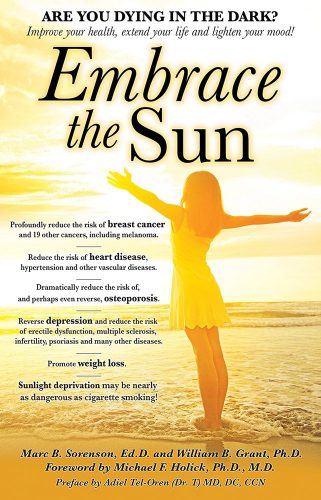
Happy sunning! And remember never to burn.

Children’s diseases associated with sun deprivation. by Marc Sorenson, EdD
Children’s diseases that are associated with sun deprivation are legion. So, how do I know this? Because my last five blogs discussed this topic, and I’m a long way from finishing the theme.
To subject our children to sun deprivation is child abuse. It results in either lifelong or temporary children’s diseases.
So, the first of the children’s diseases discussed this week will be acute lower respiratory infections (ALRI). In addition, the second will be attention deficit hyperactivity disorder (ADHD).
ALRI are a leading cause of sickness and mortality both in children and adults worldwide. Furthermore, ALRI are not uniformly defined and this may hamper a true appreciation of their importance. Also, from an epidemiological point of view, the definition of acute lower respiratory infections includes other diseases. The most noteworthy of these diseases are acute bronchitis and bronchiolitis, influenza and pneumonia. The NCBI also states that acute respiratory infections, and particularly lower respiratory tract infections are deadly. Another fact is that these diseases are the leading cause of death among children under five years of age. Especially relevant is that they are estimated to be responsible for between 1.9 million and 2.2 million childhood deaths globally.
Studies regarding children’s diseases indicate that sun exposure has protective effects, whether due to vitamin D production or another factor.
First of all, in one study, children placed outside in sunlight were less than half as likely to suffer ALRI. Another investigation on sunlight compared vitamin D levels and sun exposure habits in children with and without ALRI. And, there was virtually no difference in vitamin D levels between the sick and healthy groups. Yet, those children who had a higher percentage of the body exposed to sunlight were less likely to have ALRI. Therefore, this reinforces the fact that sun exposure has preventive effects beyond vitamin D for children’s diseases.
ADHD (attention deficit hyperactivity disorder) is another of the disheartening children’s diseases.
ADHD is the most prevalent of mental disorders in children. And, it causes significant problems with executive functions (e.g. attentional control and inhibitory control). In addition, it causes attention deficits, hyperactivity, or impulsiveness not appropriate for a person’s age. Thus, it is certainly another of the important children’s diseases. Also, researchers have found that sun exposure correlates to a decreased risk of ADHD. The investigators assessed the relationship between ADHD prevalence and sun intensity in various nations and in US states. As a result, they found a close association between low sunlight intensity and the prevalence of ADHD. Another finding was that it explained 34%–57% of the variance in ADHD prevalence, with high sunlight intensity having a preventive effect.
It seems like the advice to deprive our children of sun exposure, in order to a prevent melanoma, is disastrous. Do we want to increase the chance of ALRI, ADHD or other children’s diseases we have already discussed? In conclusion, let’s love our children and be sure that they receive plenty of regular, non-burning sun exposure. And for more information, read the book, Embrace the Sun.
Happy sunning!

Melanoma risk is prevented by sun exposure. Case closed! -By Marc Sorenson, EdD
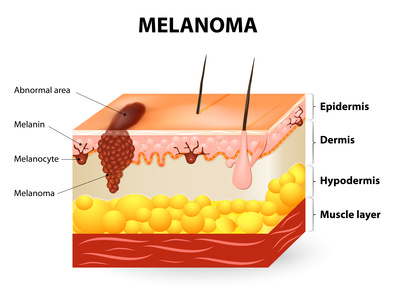
Melanoma risk between persons with high and low vitamin D levels
Melanoma risk is probably the most misunderstood topic in medicine. I recently wrote about the inverse association between vitamin D and melanoma. But I finally decided that my case had insufficient passion and surety. Consequently, I decided to write this addition and provide some new and restated information.
Melanoma risk is directly associated with low levels of vitamin D. That is the conclusion of recent study published in the European Journal of Cancer.[1] The investigators measured the blood vitamin D levels of 137 subjects who had been diagnosed with melanoma. They collected the blood samples at the time of diagnosis of the disease. Another group of 99 healthy subjects served as the control group. The investigators collected the samples of the control group between October and April. The scientists then compared the blood collections of the melanoma group with those of the control group. They then determined whether vitamin D levels had an association with melanoma risk.
The study produced convincing results regarding vitamin D and melanoma risk.
The results were as follows:
- The controls (no melanoma) had vitamin D levels 50% higher than the melanoma group (27.8 ng/ml vs. 18 ng/ml).
- 66.2% of the melanoma group had vitamin D “deficiency,” compared to only 15.2% of the health controls. The scientists defined vitamin D deficiency as being equal to or less than 20 ng/ml. So, the melanoma group had more than four-times the risk of deficiency.
- The scientists defined vitamin D “sufficiency” as being equal to or greater than 30 ng/ml. They found that only 7.4% of melanoma patients were sufficient, compared to 37.4% of healthy controls. Hence, the melanoma group had about one-fifth the likelihood of having sufficient D levels.
More scientific analysis on vitamin D measurements vs. melanoma risk
The scientists then adjusted the data for possible confounding factors such as age, sex and body mass. Then, they performed an analysis that showed the following:
- First of all, a significant inverse association was demonstrated with vitamin D sufficiency versus deficiency. Those who had sufficient levels had only 4% of the melanoma risk when compared to those who were deficient! Hence, this would indicate that those with the lowest vitamin D levels (after adjusting for confounding factors) had 25-times the melanoma risk!
- And, vitamin D insufficiency vs. deficiency was significantly inversely associated with melanoma. Those who were insufficient had a definite advantage over those who were deficient. They had only 13% of the melanoma risk.
Now, let’s get to the most important point about melanoma risk:
In addition, this research proves conclusively that sun deprivation is a major cause of melanoma. Therefore, vitamin D levels are surrogate measurements for sun exposure in nearly every case. And why do I say than this research conclusively proves that sun exposure reduces melanoma risk? Because about 90% of serum vitamin D is produced by sun exposure to the skin.[2] So, the aforementioned research is really research on sun exposure. It indicates that regular sun exposure leads to a profoundly higher vitamin D levels and therefore a profoundly reduced melanoma risk. So, let’s restate the facts about vitamin D, sunlight and melanoma.
- First of all, sunlight exposure to skin produces 90% of the vitamin D levels in the public.
- Secondly, the higher the vitamin D levels, the lower is the risk of melanoma.
- Therefore, high sun exposure reduces melanoma risk.
- Case closed!
Nevertheless, there is more corroborating evidence for the case.
In addition, here are a few more facts indicative of sun exposure’s protective effect against melanoma risk:
- Another supporting fact: 75% of melanomas occur on body areas that are seldom if never exposed to sunlight.[3]
- In addition, sun exposure decreased by 90% since 1935, while melanoma increased by 3,000%.[4]
- Also, in the past four decades, melanoma has increased 400% while sunscreen use also increased 400%.[5]
- Furthermore, sunburn is said to increase melanoma risk. And recent research shows that sunscreen use increases the risk of sunburn from 300-600%.[6]
Could sunlight reduce melanoma through photoproducts beyond vitamin D?
In conclusion: In my new book, Embrace the Sun (coauthored by Dr. William Grant), we note that sun exposure provides more than vitamin D. It also provides other photoproducts such as nitric oxide, serotonin, endorphin, and brain-derived neurotropic factor (BDNF). All of these photoproducts are vital to human health. Could these photoproducts have a positive and protective effect against melanoma risk beyond vitamin D? And, who is to say that the vitamin D produced by sunlight is not superior to that given in pill form?
Finally, this research gives us one more reason to embrace the sun safely without burning. And who would have thought that safe sunlight could be one of the best prophylactics against melanoma risk?

Happy sunning! Do not burn.
The book is available at Amazon: https://www.amazon.com/Embrace-Sun-Marc-B-Sorenson/dp/069207600X
[1] Cattaruzza MS, Pisani D, Fidanza L, Gandini S, Marmo G, Narcisi A, Bartolazzi A, Carlesimo M. 25-Hydroxyvitamin D serum levels and melanoma risk: a case-control study and evidence synthesis of clinical epidemiological studies. Eur J Cancer Prev. 2018 Feb 12. [Epub ahead of print]
[2] Reichrath J. The challenge resulting from positive and negative effects of sun: how much solar UV exposure is appropriate to balance between risks of vitamin D deficiency and skin cancer? Prog Biophys Mol Biol 2006;92(1):9-16
[3] Crombie IK. Distribution of malignant melanoma on the body surface.Br J Cancer. 1981 Jun;43(6):842-9.
[4] Melanoma International Foundation, 2007 Facts about melanoma. Sources: National Cancer Institute 2007 SEER Database, American Cancer Society’s 2007 Facts and Figures, The Skin Cancer Foundation, The American Academy of Dermatology.
[5] Joseph C DiNardo and Craig A Downs. Should We Use Products Containing Chemical UV Absorbing Sunscreen Actives on Children? Clin Dermatol Res J 2019, 4:1.
[6] Kasey L. Morris, PhD; Frank M. Perna, EdD, PhD. Decision Tree Model vs Traditional Measures to Identify Patterns of Sun-Protective Behaviors and Sun Sensitivity Associated With Sunburn. JAMA Dermatol. Published online June 27, 2018.

